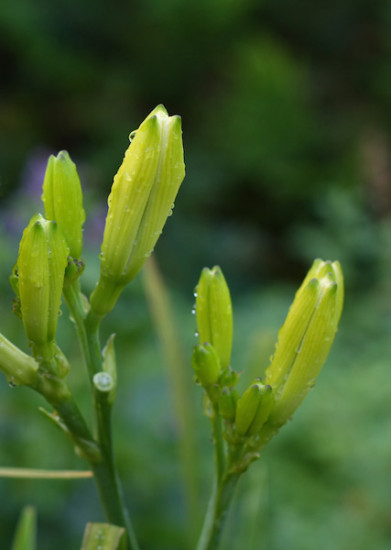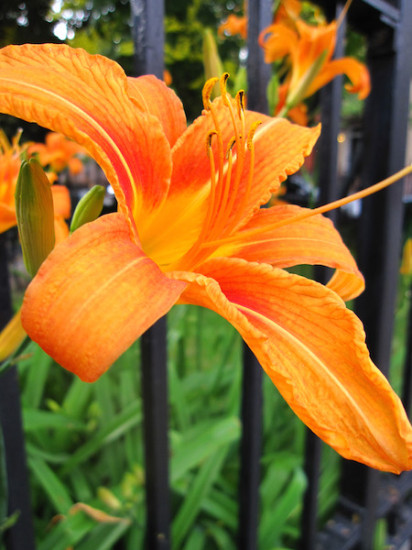Hemerocallis fulva is probably in bright bloom across Manhattan as you read this. The familiar long-stemmed flowers are the bright-orange standard bearers of early summer. But while they’re beloved in bouquets, they are even better in salad bowls.
Although often mistaken for an American wildflower, day lilies came from East Asia via England, escaping Colonial gardens early in their American life, and naturalizing here, growing in tall, bullying clumps that precluded more timorous native species. Day lily is the common name for the multitudinous genus Hemerocallis, which comprises over a dozen species and tens of thousands of cultivars, gaining new ones every season. Darlings of the horticultural trade, they occur in almost every hue (except blue, but breeders are trying) and grow from coast to coast—and across Manhattan, in parks, courtyards and even on rooftops. All of them are edible.

And so much is edible in our urban landscape: lovely local ephemerals such as violets, the delicate flowers aptly named “spring beauties,” subtle trout lilies, as well as the slow-growing woodland carpets of wild ginger. But it is a hard and greedy heart that unearths clumps of these indigenous plants from a park: Wildflowers are under enough pressure within the city without having to fend off foragers, too. Personally, I would thump such an adventurer over the head with my handbag, in which I often carry several heavy lenses for my camera.
The over-competitive day lily is bad news for local species and delicious news for foragers. When sorting out my constant internal conversation about what I will and won’t pick, this distinction factors high.
Sustainable foraging focuses on a world I have come to love: invasive weeds. These are aggressive, successful and sometimes delectable plants that have arrived from another clime and made themselves very much at home, to the detriment of local plant populations. I am here to help. I will eat the weeds—as should you. Together, as gardeners, foragers and cooks we can turn away from weed control with poison and turn toward our chopping boards.
Because day lilies belong to the botanical family Liliaceae, they are sometimes confused with the genus Lilium—which can get very unpleasant, as many of those plants have poisonous parts. To confuse things further, day lilies are sometimes known as tiger lilies. But that is also an accepted common name of Lilium lancifolium, an Asian lily with poisonous raw buds, poisonous spotted flowers (also orange) and poisonous leaves. Its bulbs, however, are edible when cooked. Know thy lily! And learn thy Latin.
The closed day lily buds are perfect raw in salads—crunchy, yielding, slightly sweet. Steamed, they are a delicate, green beanish treat needing little more than a suggestion of melted butter and a nip of salt. Gently pickled in vinegar, they pair well with sweet spices such as allspice or cloves. Dried and rehydrated, the viscous buds are the golden needles of hot and sour soup. You can buy them in Chinatown, sometimes labeled helpfully as “dried lily buds.”
And while I have nothing against the flavor of fancy Hemerocallis hybrids, these are usually planted by parks employees or homeowners, so I steer clear. Sneaking a bud from a cultivated plant is uncouth. So in June, when day lilies dot the landscape, I take the A train up to Inwood Hill Park, where the plant has taken over, uninvited. Here I gather my buds, guilt-free. It’s a long ride from Brooklyn, but worth the wait.
The spent flower, however, is fair game, no matter where you find it: Just-withered blooms make a very good cooked vegetable. The Chinese and Japanese have known this for eons. And if you are dexterous, these delicate, fragile day-old petals can be persuaded to accommodate a simple stuffing, à la zucchini blossom. Bread crumbs, ricotta, a speckling of lemon zest, a panful of foaming sweet butter …
But that’s not all: The best part of this generous plant is arguably its small, fleshy rhizomes underground, though now is not the time to gather them. They are fatter and crunchier in very early spring when their green shoots have just broken the surface (and are consequently harder to identify). Map your day lily stash this summer, and return next March, with a little shovel. I’ll be here to tell you what to do with them…
Quick-Pickled Day Lily Buds
With any new food, always taste a small amount first. A minority of people report allergic reactions to day lilies (similar to a reaction to Jerusalem artichokes/sunchokes).
Day lilies are mild and delicate, so I don’t like to overwhelm their flavor by brining or boiling. Instead, I find them a perfect match for the quick-pickle method. Eat them as toppings on tacos, on bánh mì (for these, substitute lemongrass and garlic for the cinnamon and cloves) or straight up.
¼ cup white wine vinegar
½ cup water (or enough to cover the buds in bowl)
2 teaspoon salt
1 tablespoon plus 1 teaspoon sugar
3 cloves
1 stick cinnamon
10 peppercorns
1 cup closed, pale lily buds, stems cut off
In a small saucepan, combine the vinegar, water, salt, sugar and spices. Heat till simmering and then remove from heat. Place buds in a bowl. When vinegar mixture has cooled, pour over the buds, weighing them down with a saucer to keep submerged, and transfer to refrigerator. They are ready after an hour and will keep for several days.
Article originally posted on May 1st, 2012.






